Top News

February 7, 2020 Ryukyu Shimpo
Between January 28 and February 2, graduation projects by the 33 third-year students in the Shuri High School Department of Dyeing and Weaving Design were displayed in the 60th Dyeing and Weaving Exhibition at the Naha Shimin Gallery in Kumoji, Naha.
One hundred and forty-six student works including kijaku (cloth used to make traditional Japanese clothing) and neckties were on display. One work that stood out among these was a mural (2.5 m high and 11.8 m across), which was a collaboration by all of the third-year students.
The theme of the mural is “Past and Future” and is an illustration of the philosophies of Shuri High School, kaiho youshu (developing talent on a waterlocked nation) and shinten douchi (earth-shaking). Students chose Shuri Castle, which burned down in October, 2019, as the primary subject. Students symbolized their hopes for the future in the koi fish motif. A group of fish swim upstream, cresting rough waves, and eventually changing into a bold dragon that reigns over earth and sky. The work is imbued with the students’ hope that Shuri Castle will be restored as soon as possible and their determination to support the castle no matter where their journeys take them.
The subject of the mural was not Shuri Castle originally, but changed after the castle burned down. The students started the mural in November and spent about two months completing it. The mural was separated into six sheets and designed by four students. The rest of the students worked together to dye the fabric and finish the piece.
Shuichi Okada says, “I first realized what a big presence the castle had and how important it was after it burned down.” Kairi Sunabe says, “Shuri Castle was here. I put that feeling into this piece.” Toko Urasaki lives in Nakagusuku. She drew attention to a point she worked hard on, saying, “I wanted to create depth and to make sure it left an impression, so I was very particular about the red I used.”
(English translation by T&CT and Ellen Huntley)
Go to Japanese
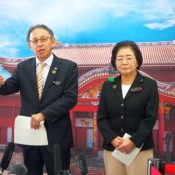
February 6, 2020 Ryukyu Shimpo
On February 6, Okinawa Governor Denny Tamaki and Naha City Mayor Mikiko Shiroma held an interview at the Prefectural Office and confirmed that the Okinawa prefectural government will coordinate with the central government toward allocating donations for the reconstruction of Shuri Castle, contributed from both within and outside of Okinawa, to the development of facilities within the castle such as the main temple building.
As of February 5, donations contributed from both within Japan and abroad have amounted to about 1.366 billion yen. Mayor Shiroma has come out with a policy of entrusting donations collected within Naha City to the Okinawa prefectural government.
After the interview, Governor Tamaki said to the gathered press, “We would like Okinawa’s citizenry to be the core of handling the reconstruction of Shuri Castle, in the way entrusted to the prefecture and Naha City (the donations)”. In terms of whether the restoration of Shuri Castle will become a joint venture with the central government, and in terms of the specific methods by which the restoration will be done, such as if facilities will be handled one-by-one, Governor Tamaki simply said, “There are various speculations; I look forward to discussing with the central government”.
(English translation by T&CT and Erin Jones)
Go to Japanese
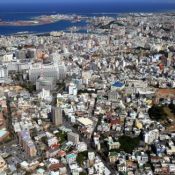
February 1, 2020 Ryukyu Shimpo
The estimated prefectural population as of January 1, 2020, announced by the Okinawa Prefecture Statistics Division on January 31, was 1,456,417, an increase of 618 people (0.04%) from the previous month, and an increase of 5,482 people (0.38%) compared to January 2019.
The municipality having the largest rate of increase relative to January 2019 was Nakagusuku Village, with an increase of 2.26%, and next was Miyakojima City, with an increase of 1.63%.
The municipality with the largest rate of decrease was Tonaki Village, with a decrease of 5.29%, and next was Tarama Village, with a decrease of 4.31%.
(English translation by T&CT and Sandi Aritza)
Go To Japanese
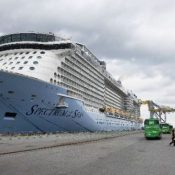
January 30, 2020 Ryukyu Shimpo
Amid the spread of the corona virus, China has put in place restrictions such as the banning of group travel, and as a result on two cruise ships containing no passengers arrived at Naha Port January 29.
In addition to the Chinese passengers who had to cancel their travel plans, as a measure to stem the spread of the virus the cruise line made the decisions to temporarily stop accepting passengers.
Instead, they took on cargo for transport while docked at the port.
The two ships that arrived without passengers were the Costa Cruises’ (United Kingdom) ship Costa Venezia (approx. 135,000 tons, 5,200 passenger capacity) and the Royal Caribbean Cruises’ (United States) ship Spectrum of the Seas (approx. 168,000 tons, 4,200 passenger capacity).
Costa Cruises also decided to cancel a voyage scheduled to depart from China operating from January 25 through February 4.
According to the company, since they were required to take on food and cargo at the port, they had to depart despite not having any passengers.
Naha Port Authority (NPA) Permanent Executive Vice President Takefumi Tahara said “Having just become the top port Japan for ship arrivals, we are concerned about this will affect the number of visits.
A decrease in souvenir shopping and dining by cruise ship passengers will have a major impact on Okinawa’s economy.”
(English translation by T&CT and Sam Grieb)
Go To Japanese
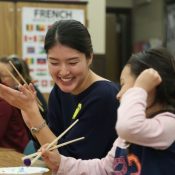
February 2, 2020 Ryukyu Shimpo
By Tamiko Suzuki
Virginia, U.S.A.—Minae Uehara, Japan Outreach Initiative (JOI) coordinator of the Japan Foundation Center for Global Partnership, is working hard to get students and kids interested in Japan.
Uehara, a native of Oroku, Naha City, was assigned to the University of Mary Washington, where she teaches classes on Japanese culture.
Her classes are organized in to six themes, including Traditional Japanese Music in which she plays the sanshin (Okinawan banjo) she brought from Okinawa, to showcase traditional Okinawan performance arts.
In her Minorities in Japan lecture, she spoke about Okinawa and the indigenous Ryukyuan language, as well as the Ainu people in Japan.
In addition to teaching university students, Uehara visits local elementary, middle and high schools to talk about Japanese culture.
Using her mastery in Japanese calligraphy, Uehara designed activities for kids to learn about the art, in which they write on uchiwa (paper paddle fans) with a brush and ink.
Uehara said about cross-cultural understanding, “In the U.S., people of various ethnicities work together.
Even at my current workplace, most people come from different cultural backgrounds.
Rather than assimilating to one culture, they place value on individuality, so cross-cultural understanding, or in essence respecting each other’s culture, comes naturally.”
Uehara shared a lesson she learned: “The important thing is to be direct and voice your opinions.
In Japan, we often imply and infer, but that communication style breaks down [in the U.S.]” She explained, “Americans are good at expressing their opinions while being considerate to each other.
I learned that there are words that act as cushions [to buffer a blow.] I was thrown at first but now in my second year, I’ve adjusted to the environment and I live a happy life.”
Uehara is full of determination. “I want to find a career where I can offer a nudge to the future generation of young Okinawans who are outward-looking and might be interested in studying abroad.”
The Center for Global Partnership, founded by the Japan Foundation, has delegated JOI coordinators since 2002 as part of its program, which aims to promote mutual understanding between the U.S. and Japan.
JOI coordinators act as bridges between the two countries, and the Center has delegated about 70 coordinators thus far to colleges and Japan-America Societies across America.
Coordinators are required to have an excellent command of the English language and are selected after completing a written test and interviews in both Japanese and English.
(English translation by T&CT and Monica Shingaki)
Go To Japanese
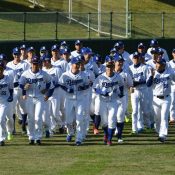
February 1, 2020 Ryukyu Shimpo
Japanese professional baseball kicked off their spring training camp February 1, with eight teams starting their training camps in various locations around Okinawa: the first string players for the Hanshin Tigers (Ginoza), Hokkaido Nippon Ham Fighters (Nago), Chunichi Dragons (Chatan), Yokohama DeNA BayStars (Ginowan), Chiba Lotte Marines (Ishigaki), and the second string players for the Hiroshima Carp.
The first string players for the Carp and the Yomiuri Giants will also come to Okinawa as needed in mid-February.
The Ginowan Municipal Stadium, which will host the Central League’s Yokohama DeNA BayStars, had a rush of fans arriving early in the morning, hoping to get a glance of the players.
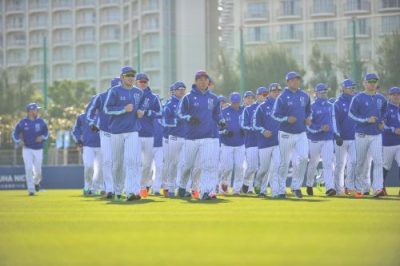
Yokohama DeNA BayStars hard at work preparing for the upcoming season at the Ginowan Municipal Stadium
There was a brief ceremony before starting, where they wished for good health and weather during the camp, before setting out for training.
At the baseball fields in Chatan, the Central League’s Chunichi Dragons started their camp with a warmup jog.

Hokkaido Nippon Ham Fighters warming up for a day of practice at the Nago City Baseball Field
(English translation by T&CT and Sam Grieb)
Go To Japanese
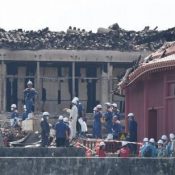
January 29, 2020 Ryukyu Shimpo
The Okinawa Prefectural Police Department’s First Investigations Division ended its investigation of the Shuri Castle fire, in which six buildings including the castle’s seiden main hall was burned to the ground.
The police department previously collected something like a cluster of electrical wires from the northeast side of the seiden, where a crowded electrical system was suspected to be the likely cause of the fire.
The electrical wires were sent to the prefectural police forensic science laboratories for analysis.
On January 29, the investigation announced the results to be inconclusive and the cause of the fire remains unknown.
Factual existence of a crime could not be established from police questionings of associated parties or from analysis of surveillance footage.
Okinawa Churashima Foundation Research Center, the designated manager of Shuri Castle Park, did not find facts to which criminal laws and regulations are applicable.
Just days before January 31, three months to the day since the fire, the investigation ended inconclusively.
According to the First Investigations Division, there were about 46 wire-like objects collected from the scene, which were analyzed by its forensic laboratory.
They found evidence of molten copper; heat from a nearby fire broke the copper wires, causing the cut section to melt and form spherical beads. However, no short circuits that may have caused the fire were found.
(English translation by T&CT and Monica Shingaki)
Go To Japanese
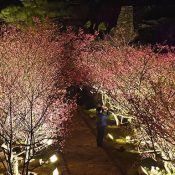
January 31, 2020 Ryukyu Shimpo
Prior to the 13th annual Nakijin Castle Cherry Blossom Festival (sponsored by the action committee for the festival), the start of which is February 1, preparations for lighting up the cherry trees and Nakijin Castle were underway.
The cold on the night of January 30 was chilling, and with the World Heritage registered castle in the background, the cherry blossoms stood out and created a wonderous scene.
The festical ends on February 9.
There are about 860 cherry trees growing on the castle grounds, and at the time of this article 7 or 8 were in bloom.
There is promise that during the festival the cherry blossoms can be enjoyed in full bloom.
(English translation by T&CT and Erin Jones)
Go To Japanese
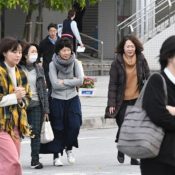
January 30, 2020 Ryukyu Shimpo
On January 30, the coldest temperatures this winter were recorded at 13 Okinawan meteorological observatories.
The cold weather was due to movement of a cold air mass in the upper atmosphere caused by a high-pressure system jutting out from the Asian continent.
At 7:41 a.m. in Oku, Kunigami and at 4:30 a.m. in Itokazu, Nanjo, the observed temperatures slipped below the coldest times of year to 11.3 C. In eight observatories around Ishigakijima the lowest temperatures this winter were recorded. In Ohara, Taketomi (Iriomote) 12.9 C was recorded.
The Okinawa Headquarters of the Japanese Meteorological Agency predict that due to the cold air mass, Okinawa will be cloudy with scattered light showers on January 30.
Starting in the afternoon strong winds from the north and north-west are expected.
The impact of the cold air mass will be strongest that night and into the morning of January 31.
Okinawa will be chilly through January 31. Temperatures are expected to return to around the seasonal average around February 2.
(English translation by T&CT and Ellen Huntley)
Go To Japanese
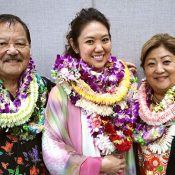
January 26, 2020 Ryukyu Shimpo
By Hanae Gushiken Higa
Waipahu, HAWAII—The Hawaii United Okinawa Association (HUOA) held its Uchinanchu of the Year Awards and Officers Installation Celebration on January 18 at the Hawaii Okinawa Center.
HUOA is comprised of 50 member clubs, each representing various towns of Okinawa.
The Uchinanchu of the Year Honorees are selected from each member club for their outstanding contribution throughout the previous year.
Hawaii Gov. David Ige, Honolulu Mayor Kirk Caldwell, and the Consul General of Japan Koichi Ito attended the celebratory event.
The venue was brimming with approximately 900 HUOA members.
This year Lynn Miyahira, 38, was appointed president. Miyahira is a fourth generation Okinawan-American with roots in Nishihara Cho (Gaja, Yonagusuku).
Her motto for HUOA this year is ukaji deebiru (Okinawan for “thanks to you.”)
Miyahira addressed the members and said, “This year marks the 120-year anniversary of the issei (first generation) [Okinawans] arrival in Hawaii.
I am filled with gratitude to our ancestors who built this wonderful uchinanchu (Okinawan) community.
It is now up to us to preserve this community into the future.” Miyahira raised a clenched fist and added, “Let’s join together and chibariyo (give it our best)!”
Lynn Miyahira’s late father, Wayne Miyahira, was also appointed HUOA president in 1990, and later served as executive director.
It is the first time a father and daughter have both served in the role. Mr. Miyahira’s theme for HUOA as president was okage sama de (standard Japanese for “thanks to you”).
Lynn chose her theme ukaji deebiru (the Okinawan translation of her father’s theme, okage sama de) as a symbolic passing of the torch from her father. She commented: “I was raised by this community.
I want to give back to it as much as I can.” The new president also gave a karate performance on stage at the event.
2020 is a special year for HUOA; it is the 120-year anniversary of the first Okinawan immigrants arriving in Hawaii, the 60th anniversary of the Honolulu-Naha City Sister City Pact, the 35th anniversary of the Hawaii-Okinawa sister-state relationship, the 30th anniversary of the Hawaii Okinawa Center, and the 30th anniversary of the Hawaii Okinawa Student Exchange Program.
The HUOA plans to throw an anniversary event in May this year.
The 2020 HUOA officers and executive council members are:
Lynn Miyahira, President; Patrick Miyashiro, President Elect; David Jones, Naomi Oshiro, and Christopher Agena, Vice President;Terry Goya, Executive Secretary; Sandra S. Yanagi, Assistant Executive Secretary; Chikako Nago, Japanese Secretary; Norman Nakasone, Treasurer; Courtney Takara, Assistant Treasurer; Jocelyn Ige, Immediate Past President; David Z. Arakawa, Jon S. Itomura, Gainor Miyashiro, Cyrus K. Tamashiro, Tom Yamamoto, Roy Arakaki, Stephanie Katayama, and Myles Nakasone, Advisor.
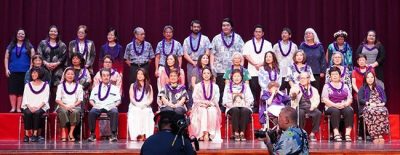
Uchinanchu of the Year Honorees on stage.
(English translation by T&CT and Monica Shingaki)
Go To Japanese
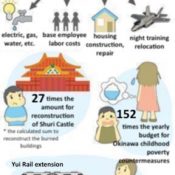
January 18, 2020 Ryukyu Shimpo
It has now been 60 years since 1960, when the U.S.-Japan Security Treaty was revised. For 60 years Okinawa has been left to suffer damage from military bases in the name of the security guarantee.
Outside of Okinawa there has been a reduction in U.S. military bases, meanwhile, the concentration ratio of military bases in Okinawa has increased.
The Abe administration pushed past Okinawa’s popular will in opposition to the construction of the Futenma Replacement Facility in Nago City, and is forcing construction through.
It can be said that the Japanese government’s posture of compliance to the United States has furthered
Okinawa’s sacrifice. The Japanese government’s compliance with the United States’ wishes has taken the form of the Japanese Self-Defense Forces (JSDF) taking on a larger scope of activities, and Japan shouldering stationing expenses for the U.S. Forces, Japan (USFJ), which Japan has no duty to pay.
The payment of U.S. military stationing expenses by Japan is called the Omoiyari Yosan (or “Sympathy Budget”) which from 1978 to 2018 reached a cumulative total of over 7.2 trillion yen (approximately 66.7 billion USD).
The burden of USFJ stationing expenses, which was originally borne by the United States, has come to be 70 percent borne by Japan as the Omoiyari Yosan.
The amount requested by the United States has been rising, reaching 197.4 billion yen (approximately 1.8 billion USD) in 2019 alone.
Although the subject of the budget has not changed, when comparing it with various public works, for example, the budget dedicated by Japan to urgent countermeasures to “Childhood Poverty” in Okinawa, the Omoiyari Yosan is 152 times the yearly “Childhood Poverty” budget.
The Okinawa prefectural government has shown preliminary calculations for the extension of the Okinawa Urban Monorail (Yui Rail), a sum which should cover the construction of 16 stations spanning 18 kilometers (a little over 11 miles).
The itemized list includes: (1) 9 stations from Onoyama Park Station through Tomigusuku City to Itoman City (98 billion yen, approximately 899 million USD), (2) 4 stations from Tedako-Uranishi Station to Nishihara Marine Town (58 billion yen, approximately 532 million USD), and (3) 3 stations from Tedako-Uranishi Station to the University of the Ryukyus (40 billion yen, approximately 367 million USD).
According to the Okinawa General Bureau, the reconstruction cost for buildings burned down in the Shuri Castle fire is about 7.3 billion yen (approximately 67 million USD).
The 2019 Omoiyari Yosan costs about 27 times the reconstruction budget of Shuri Castle.
Holding the February 19 prefectural referendum pertaining to construction of the Futenma Replacement Facility in Henoko, Nago City cost 550 million yen (approximately 5 million USD).
A portion of Okinawa’s citizens and conservative politicians were doubtful of this use of tax money. The 2019 Omoiyari Yosan costs 359 times the cost of that prefectural referendum.
In 1978 the U.S.-Japan Status of Forces Agreement (SOFA) regularized Japan sharing responsibility of USFJ stationing expenses.
At that time the Director-General Kanemaru Shin of the Japan Defense Agency expressed “We are sympathetic [to the United States]” and thus called it the “Sympathy Budget”.
Japan is bearing the costs of efforts such as the return of U.S. military bases and the relocation of trainings within Okinawa, and U.S. military reorganization expenses including the relocation of Marine Corps Air Station Futenma to Henoko, Nago City.
Policies that favor U.S. servicemembers and civilians in military employ, such as exempting them from taxes and various fees, are in effect.
The most recent information on ratios of responsibility sharing by host nations for U.S. military stationing expenses was announced by the U.S. Department of Defense in 2004.
According to the report, Japan was responsible for 74.5 percent of the U.S. military stationing costs within Japan, which greatly exceeds the responsibility sharing ratio of any other country.
There is expected to be movement toward conclusion of a new agreement in March 2021, as the Trump administration is requesting an increased sum from Japan.
(English translation by T&CT and Erin Jones)
Go To Japanese














 Webcam(Kokusai Street)
Webcam(Kokusai Street)


